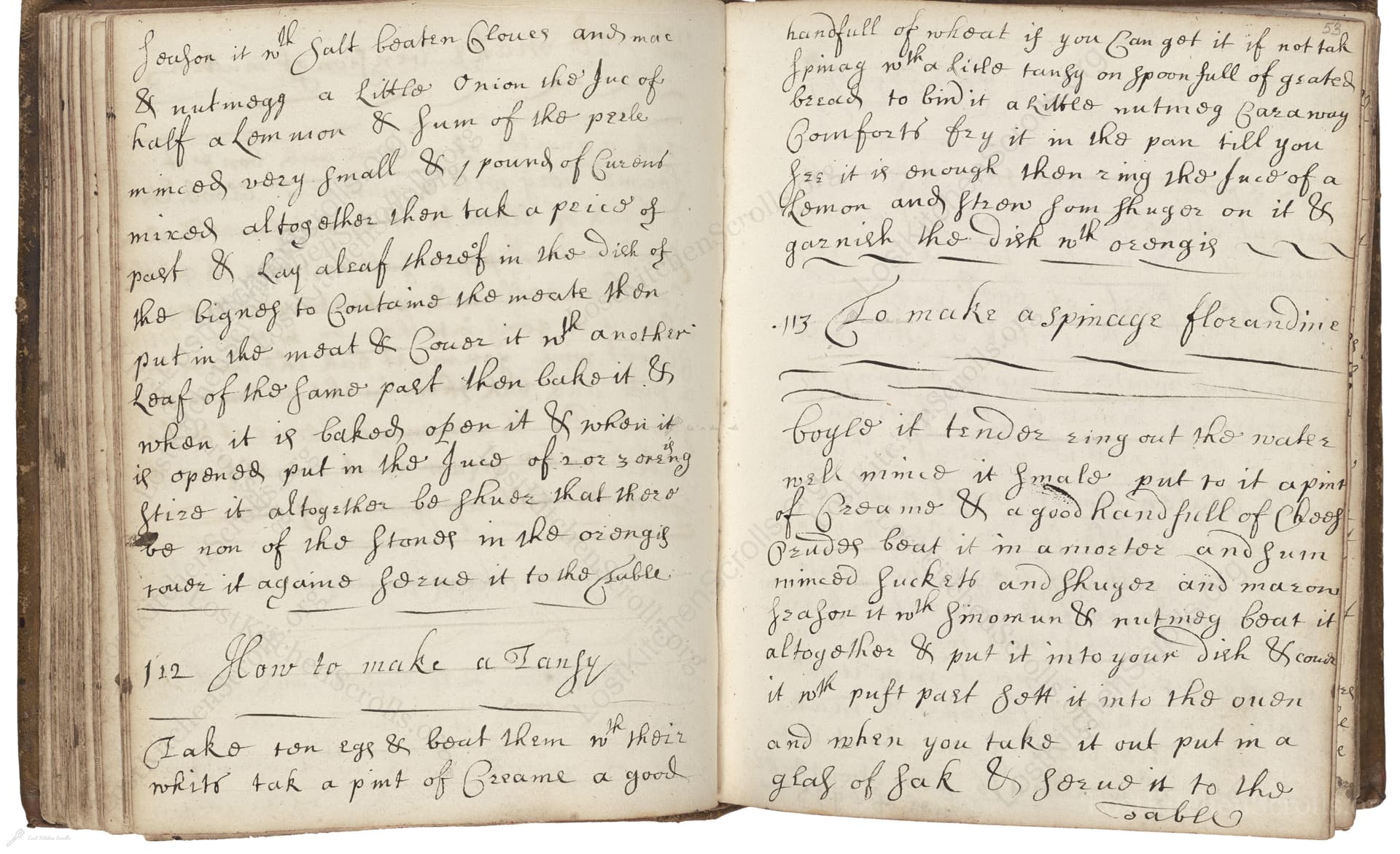How To Make A Tansy
From the treasured pages of Cookbook of Elizabeth Fowler
Written by Elizabeth Fowler

How To Make A Tansy
"Take ten eggs & beat them wth their whits tak a pint of Creame a good handfull of wheat if you Can get it if not tak spinag wth a little tansy on spoonfull of grated bread to bind it a little nutmeg Caraway Comforth fry it in the pan till you see it is enough then zing the Juc of a Lemon and strow som shugor on it & garnish the dish wth orongis"
Note on the Original Text
Early-modern recipes like this were written for experienced cooks who already knew their way around the kitchen; instructions were brief, measurements were imprecise, and spelling was highly variable—'whits' for whites, 'shugor' for sugar, and 'orongis' for oranges. The casual references to ingredients like 'wheat' and 'comforth' would have been plain to the manuscript’s original audience but are less familiar now. Tansy's poetic economy captures the improvisational, resourceful nature of cookery before modern standardization and spelling reforms.

Title
Cookbook of Elizabeth Fowler (1684)
You can also click the book image above to peruse the original tome
Writer
Elizabeth Fowler
Era
1684
Publisher
Unknown
Background
A charming window into the kitchens of 17th-century England, this cookbook authored by the accomplished Elizabeth Fowler invites you to explore a delectable world of historic recipes, tempting sweets, and elegant table fare fit for any refined palate.
Kindly made available by
Folger Shakespeare Library
This delightful 17th-century recipe—the Tansy—comes from the manuscript of Elizabeth Fowler, dated 1684. Dishes called 'tansy' were traditional Lenten fare in England, their bright green color and bitter herbal notes a nod to spring renewal and cleansing. Tansy, the herb, was once widely used for both flavor and supposed health benefits, especially at Easter after months of winter fare and fasting. The inclusion of young wheat (or later, spinach) reflects the seasonal cycles of what was available in the early spring kitchen. Elizabeth Fowler’s handwritten collection captures English gentry household cooking in Restoration England, with its blend of practicality, herbal lore, and evolving culinary sophistication.

In a late-17th-century kitchen, this Tansy would have been prepared using a large earthenware or pewter mixing bowl and a wooden whisk or beater to thoroughly combine the eggs and cream. The greens and herbs would have been chopped finely with a small knife or herb chopper. The mixture was fried in a heavy skillet (likely cast iron or copper, lined with tin) over an open hearth fire, managed either on a trivet or by suspending the pan over hot coals. Lemons and oranges were treasured imports and would be sliced thinly with care, and sugar, still a prized commodity, would be pounded from cones and dusted atop the finished dish.
Prep Time
15 mins
Cook Time
15 mins
Servings
6
We've done our best to adapt this historical recipe for modern kitchens, but some details may still need refinement. We warmly welcome feedback from fellow cooks and culinary historians — your insights support the entire community!
Ingredients
- 10 large eggs
- 2 cups double cream
- 1 good handful young wheat leaves (if unavailable, substitute with 1 good handful spinach leaves)
- 1 tablespoon (0.35-0.5 oz) fresh tansy leaves, finely chopped
- 1 tablespoon (0.35-0.5 oz) breadcrumbs
- 1/4 teaspoon ground nutmeg
- 1/2 teaspoon caraway seeds
- 1 tablespoon (optional) finely chopped comfrey leaves (see note on safety; can substitute with more spinach or omit)
- 1 lemon (juice)
- 2 tablespoons superfine (caster) sugar (or to taste)
- Butter, for frying
- Slices of fresh orange or candied orange peel, for garnish
Instructions
- Begin by cracking 10 large eggs into a mixing bowl, including both yolks and whites, and beat them well.
- Add 2 cups of double (heavy) cream.
- If you can find young wheat leaves, chop up a generous handful and add them in.
- If not available, use spinach instead, finely shredded, along with a small amount of fresh tansy leaves—about a tablespoon, finely chopped.
- Mix in 1 heaping tablespoon (about 0.35–0.5 oz) of fine breadcrumbs to help bind the batter, followed by a pinch each of ground nutmeg, caraway seeds, and comfrey leaves if you can source them safely for culinary use (note: comfrey is rarely used today due to health concerns; you may omit or substitute with extra greens).
- Preheat a frying pan with some butter over medium heat.
- Pour in your egg and cream mixture, cooking gently, similar to a thick omelette or frittata, until set but still tender.
- Once cooked through, squeeze the juice of one lemon over the surface, sprinkle with superfine sugar to taste, and serve garnished with thin slices of orange or candied orange peel for a decorative flourish.
Estimated Calories
350 per serving
Cooking Estimates
Preparing and cooking this dish takes about 15 minutes each. The recipe makes about 6 servings. Each serving is roughly 350 calories, based mainly on eggs and cream.
As noted above, we have made our best effort to translate and adapt this historical recipe for modern kitchens, taking into account ingredients nowadays, cooking techniques, measurements, and so on. However, historical recipes often contain assumptions that require interpretation.
We'd love for anyone to help improve these adaptations. Community contributions are highly welcome. If you have suggestions, corrections, or cooking tips based on your experience with this recipe, please share them below.
Join the Discussion
Rate This Recipe
Dietary Preference
Main Ingredients
Culinary Technique
Occasions

Den Bockfisch In Einer Fleisch Suppen Zu Kochen
This recipe hails from a German manuscript cookbook compiled in 1696, a time whe...

Die Grieß Nudlen Zumachen
This recipe comes from a rather mysterious manuscript cookbook, penned anonymous...

Ein Boudain
This recipe comes from an anonymous German-language manuscript cookbook from 169...

Ein Gesaltzen Citroni
This recipe, dating from 1696, comes from an extensive anonymous German cookbook...
Browse our complete collection of time-honored recipes



